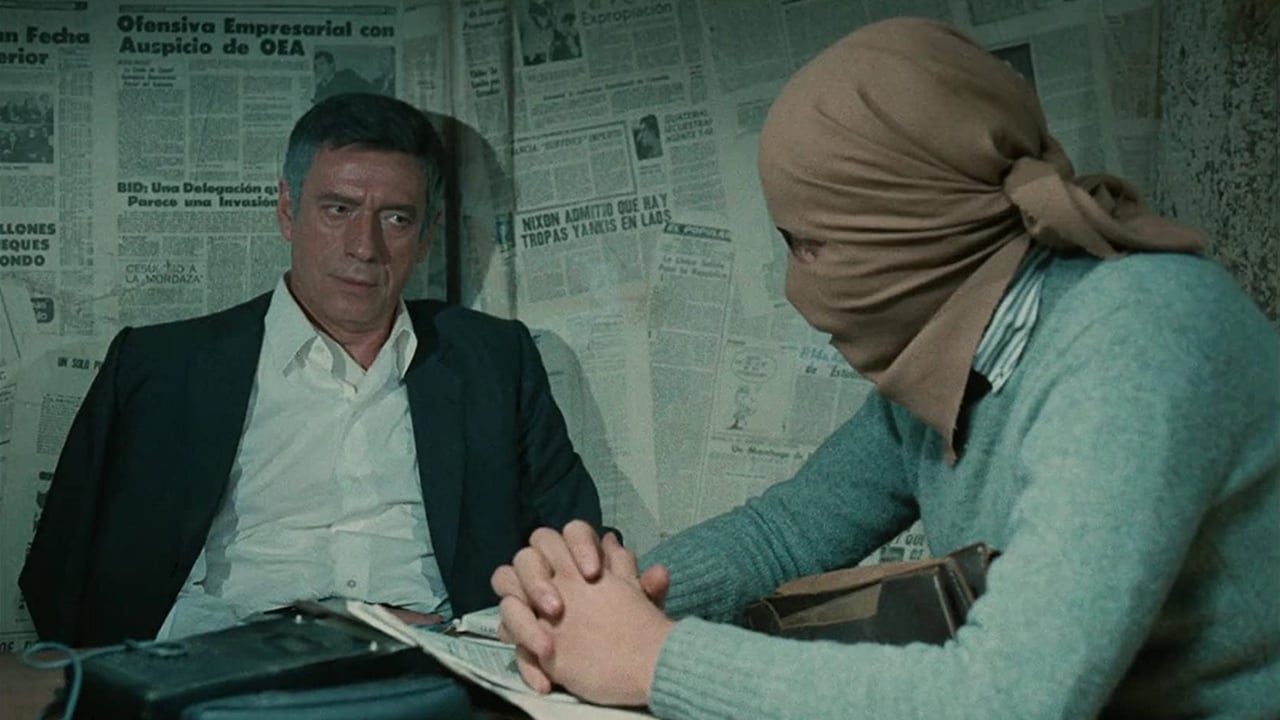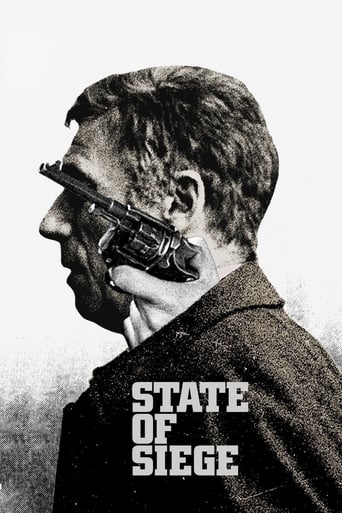Reptileenbu
Did you people see the same film I saw?
GarnettTeenage
The film was still a fun one that will make you laugh and have you leaving the theater feeling like you just stole something valuable and got away with it.
Hattie
I didn’t really have many expectations going into the movie (good or bad), but I actually really enjoyed it. I really liked the characters and the banter between them.
Staci Frederick
Blistering performances.
johcafra
A superior film in every way. I last viewed it Stateside, dubbed into English, on a public-television broadcast perhaps 25 years ago. It appears available on VHS at collectors' prices, but I'd very much prefer to see it treated on DVD as was lately done to "Z," remastered, subtitled, and with as many bonus features as possible.You may recognize more of Costa-Gavras's stock players besides Yves Montand. One noticeable stylistic difference: Given the grimness of its scenario "Z" occasionally bemuses, but State of Siege does not, even when Theodorakis's theme song tries to distract you.This said, for its narrative style and documentary look, is State of Siege a representation of a true story or merely "based upon"? At least this American chooses not to judge without having the unalloyed facts arrayed before him. The film did succeed in the sense that it made me want to learn more about its subject.The long out-of-print companion book contains Solinas's screenplay, stills from the film, a statement by Montand, and supplemental published materials presumably used in research with an extensive bibliography. Perhaps its most revealing component is the transcribed interview by Nicholas Ray of Solinas and Costa-Gavras, which mentions among other things tape recordings of the captive on whom Montand's character is based. Yet it is Costa-Gavras' final statement on the choice of filming location that is at once funny, sad and chilling in hindsight, and provides ample proof that times change.
zardoz12
A fictionalized account of the early 1970's kidnapping of Daniel Mitrione by the Uruguayan Tupamaro terrorist group, "State of Siege" is almost a mirror image of the director's previous film "Z." Mitrione (here called Phillip Michael Santore and played by Yves Montrand) is ostensibly working for USAID, but in reality - a reality uncovered for the viewer as the Tupamaros hold recorded interrogations - he trains the Uruguayan police and associated hangers-on how to torture suspects electrically, run death squads, and destroy the Tupamoros. Outside of the terrorist safehouse a newspaper reporter witnesses how the US government covers for Santore, the Uruguayan crackdown on dissent, and the aftermath. The repression is carried to rediculous extremes; the police storm the national univercity. As the police enter a courtyard, a PA speaker begins playing a revolutionary anthem. They quicky destroy it, when another speaker then blares out the anthem. That too is destroyed, and then another. Somewhere out of sight another squakbox begins playing the anthem, and the police rush off camera.I call "Etat de siege" a mirror of "Z" because the picture takes place in flashback, the director is willing to hint where the picture is set at the beginning (the car which plays an important part has a Montevideo license plate), and the director is willing to say who is really backing the repression. Most importantly, however, is that the main character is the exact opposite of the politician in the previous film. Santore is willing to use midaeval means to keep South America an apolitical market for American goods and seller of raw materials for US industry, though he hides behind the banner of anticommunism. The politico in "Z" only wanted to keep Greece a non-nuclear power.
oscar jubis
State of Siege shows how the U.S. aided and abetted right-wing dictatorships in Latin America during the Cold War. Yves Montand plays an American sent by our government to teach torture techniques to police in Uruguay. He is kidnapped by Tupamaro guerillas, interrogated and presented with proof of his activities. We witness how the military, the diplomats, and the press deal with the crisis. State of Siege generates a great deal of tension and suspense, even though we know the outcome. Director Costa-Gavras tends to romanticize the Left, but what is presented here is now widely acknowledged as fact. State of Siege is a film of historical importance that deserves your attention.
Juan Pablo Moreno
In May, 2002 they are fulfilled 30 years of the beginning of the filming of this movie in several leases of Chile (Santiago, Viña del Mar, Valparaíso and Playa Ancha). It was in the second year of the socialistic government of the President Allende and the tension that is perceived in the movie was the one that already was living through the country a year before the military coup of 1973. The Chileans only we could see this movie 2001 and in an alone cinema-art in Santiago that exhibited it for two weeks. In May, 2002 the channel of French cable TV5 exhibited "State of Siege" four times, which has allowed a deeper critical review and to recognize a series of places of the Chile of 30 years ago, which already do not exist or which are now deeply modified. Besides the climate of the epoch there is perceived the precarious or simple car equipment that Chileans were having in that epoch in which the cars of luxury were the Dodge Dart Chrysler (assembled in the northern port of Arica) and the Peugeot 404 (assembled in Los Andes, 100 kms. from Santiago). The car of the well-off middle class was the Fiat 125 and en their juvenile sectors the ideal was a Mini Austin 850. In the installed middle class there were meeting old Renault 4S (the "renolas" o "renoletas"), VW beetles, Simca 1000 and principally the popular one Citroen 2CV, known like "citroneta" o "citrola". The movie allows to see brief the juvenile or young faces of approximately 30 actors, the majority today mature and well known and to wonder for the identities of others that probably retired, they did not come back from exile or were murdered or disappear during the dictatorship. In short an intelligent and nervous "thriller", in "Z" style, which showing the hard political reality of Uruguay between 1970 and 1972. The film allows a nostalgic look and indicative on the Chile that was on the way to disappear due the Coup d'Etat of 11 of september, 1973.

